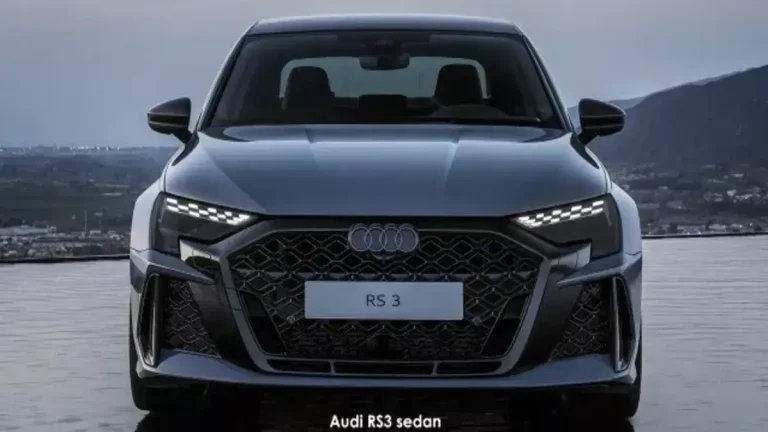The Audi RS3 has long been a benchmark in the compact performance segment the car that pushed BMW M and Mercedes-AMG to raise their game. A few years back, it was the first to crack the sub-four-second 0–100 km/h barrier, while its rivals were still climbing out of the fives.
Thank you for reading this post, don't forget to subscribe!So, what’s new with the 2025 Audi RS3 Sedan? A lot has changed since the current generation debuted in 2022. Let’s take a closer look.
Sharper Styling and Subtle Refinements
Audi has given the RS3 a fresh look with wider fenders, redesigned front and rear bumpers, a more aggressive rear diffuser, and larger exhaust outlets. A new lighting signature and cleaner grille design now without the RS badge complete the exterior tweaks.

Inside, the steering wheel gets a bold update with Alcantara wrapping and a new flat-top-and-bottom shape. Whether you like it or not, it adds a distinct character to the cabin. Carbon fibre inlays, part of the Carbon Edition trim, give the interior a sporty, premium edge. Audi has also refined the RS-specific digital displays, though the changes are more noticeable to those familiar with the older model.
Key Features of the 2025 Audi RS3 Sedan
| Feature | Specification / Update |
|---|---|
| Engine | 2.5-litre 5-cylinder TFSI |
| Power Output | 294 kW |
| Torque | 500 Nm |
| Drivetrain | Audi quattro all-wheel drive |
| 0–100 km/h | 4.07 seconds |
| Top Half-Mile Speed | 220 km/h |
| Transmission | 7-speed dual-clutch automatic |
| Suspension | Adaptive dampers, revised for better agility |
| Exterior | Wider fenders, new bumpers, diffuser, larger exhaust |
| Interior | Alcantara flat-top-bottom steering wheel, carbon inlays |
| Price (South Africa) | ± R1.6 million |
A More Playful Performer
Under the hood, the legendary 2.5-litre five-cylinder TFSI engine remains unchanged, producing 294 kW and 500 Nm of torque. Power is delivered to all four wheels through Audi’s proven quattro system.
The real transformation comes from the chassis and handling setup. Audi has tweaked the adaptive dampers, reworked the differential to allow more rear-biased cornering, and widened the rear track for added grip. The result is a more agile and engaging driving experience.
On paper, it’s actually slightly slower than before: 0–100 km/h now takes 4.07 seconds, compared to the 2022 model’s 3.92 seconds. At the half-mile mark, it’s also down by 9 km/h 220 km/h versus 229 km/h. But in return, the RS3 is far more composed and playful through corners. It’s a car designed to entertain, not just chase straight-line numbers.

Competition Check: BMW Pulls Ahead
Mercedes-AMG hasn’t made any big moves since 2022. The A 45 S still puts out 310 kW and 500 Nm, good for a 0–100 km/h sprint in 4.15 seconds. BMW, however, has turned up the heat.
The M2 lineup has evolved significantly. From the original 272 kW model to the current 338 kW/550 Nm version, BMW has kept its compact coupe at the sharp end of the segment. With its new eight-speed automatic, the M2 now blasts from 0–100 km/h in 3.86 seconds and reaches 235 km/h at the half-mile a full 15 km/h quicker than the RS3.
The M2 is, without question, the faster car. But this isn’t about beating BMW. It’s about how much better the RS3 itself has become.

Verdict: A Better RS3, Even If It’s Slower
The 2025 Audi RS3 Sedan, priced at around R1.6 million, may not top the acceleration charts, but it offers a more rewarding drive. With its sharper handling, improved balance, and everyday usability, it’s arguably the best version of the RS3 yet.
For drivers wanting something different from the usual hatchbacks and coupes or those with a small family this sedan strikes a perfect balance between performance, practicality, and fun. Audi didn’t just build a faster RS3. They built a better driver’s car.
Related article: New Audi A5 Sedan Arrives in South Africa – Pricing and Features




